A right triangle is
triangle with an
angle of

(

radians).
The sides

,

, and

of such a
triangle satisfy the
Pythagorean theorem
 |
(1)
|
where the largest side is conventionally denoted

and is called the
hypotenuse. The
other two sides of lengths

and

are called
legs, or sometimes
catheti.
The favorite A-level math exam question of the protagonist Christopher in the
novel
The
Curious Incident of the Dog in the Night-Time asks for proof that a
triangle with sides of the form

,

, and

where

is a
right triangle, and that the converse does not hold (Haddon 2003, pp. 214 and
223-226).
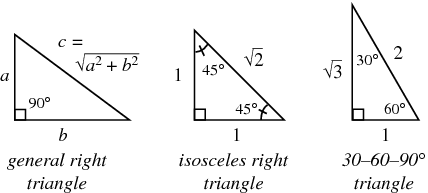
The side lengths

of a
right triangle form a so-called
Pythagorean
triple. A
triangle that is not a right triangle
is sometimes called an
oblique triangle.
Special cases of the right triangle include the
isosceles right triangle (middle figure)
and
30-60-90 triangle (right figure).
For any three similar shapes of area

on the sides of a right triangle,
 |
(2)
|
which is equivalent to the
Pythagorean
theorem.
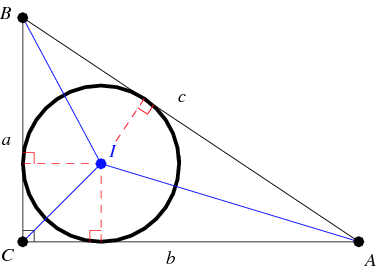
For a right triangle with sides

,

, and
hypotenuse 
, the
area is simply
 |
(3)
|
The
inradius can be found by equating the area
of the triangle

with the
sum of the areas of the three triangles

,

, and

having
the inradii as altitudes, giving
 |
(4)
|
Solving for

then gives
 |
(5)
|
This can also be written in the equivalent forms
The
hypotenuse of a right triangle is a
diameter of the triangle's
circumcircle, so the
circumradius is given by
 |
(8)
|
A
primitive right triangle is a
right triangle having integer sides

,

, and

such that

, where

is the
greatest common divisor. The set of
values

is then
known as a
primitive Pythagorean
triple.
For a right triangle with integer side lengths, any
primitive Pythagorean triple can be
written
Using these, equation (
6) becomes
which is an
integer whenever

and

are
integers (Ogilvy and Anderson 1988, p. 68).
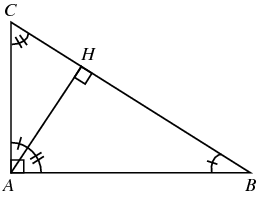
Given a right triangle

, draw the
altitude 
from the
right angle 
.
Then the triangles

and

are
similar.
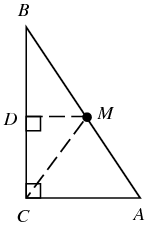
In a right triangle, the
midpoint of the
hypotenuse is equidistant from the three
polygon vertices (Dunham 1990). This can be
proved as follows. Given

, let

be the
midpoint of

(so that

). Draw

, then
since

is
similar to

, it
follows that

. Since
both

and

are right
triangles and the corresponding legs are equal, the
hypotenuses are also equal, so we have

and the
theorem is proved.
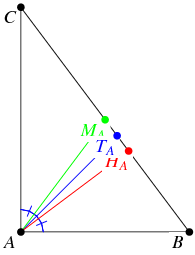
In addition, the
triangle median 
and
altitude 
of a
triangle

are
reflections about the
angle bisector 
of
 iff
iff 
is a
right triangle (G. McRae, pers. comm., May 1, 2006).
Fermat showed how to construct an arbitrary number of equiareal nonprimitive
right triangles. An analysis of
Pythagorean
triples demonstrates that the right triangle generated by a triple

has
common
area
 |
(14)
|
(Beiler 1966, pp. 126-127). The only
extremum of
this function occurs at

. Since

for

, the
smallest
area shared by three
nonprimitive right
triangles is given by

, which
results in an area of 840 and corresponds to the triplets (24, 70, 74), (40, 42,
58), and (15, 112, 113) (Beiler 1966, p. 126). One can also find quartets of
right triangles with the same
area. The
quartet having the smallest known area is (111, 6160,
6161), (231, 2960, 2969), (518, 1320, 1418), (280, 2442, 2458), with
area 
(Beiler
1966, p. 127). Guy (1994) gives additional information.
It is also possible to find sets of three and four right triangles having the
same
perimeter (Beiler 1966, pp. 131-132).
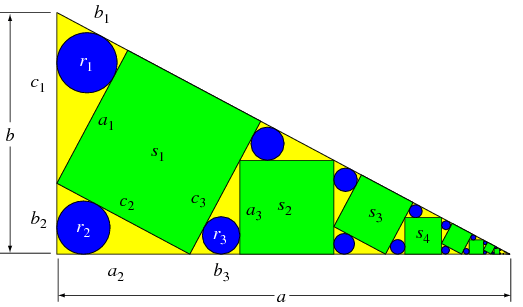
In a given right triangle, an infinite sequence of squares that alternately
lie on the
hypotenuse and longest leg can be
constructed, as illustrated above. These create a sequence of increasingly
smaller similar right triangles. Let the original triangle have legs of lengths

and

and
hypotenuse of length

. Also define
Then the sides of the

square are
of length
 |
(17)
|
Number the upper left triangle as 1, and then the remainder by following the
"strip" of triangles at adjoining vertices. Then the side lengths of these
triangles are
The
inradii of the corresponding triangles can
be found from
 |
(21)
|
giving
 |
(22)
|
A
Sangaku problem from 1913 in the Miyagi
Prefecture asks for the relationships between the first, third, and fifth
inradii (Rothman 1998). This can be solved using elementary
trigonometry as well as the explicit equations
given above, and has solution











댓글 없음:
댓글 쓰기